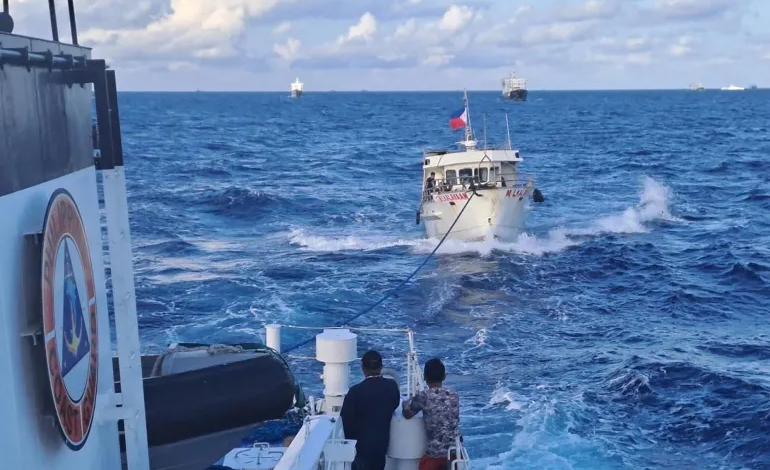The Philippines-China South China Sea Dispute: A Complex Web of Sovereignty, Security, and Strategy

The South China Sea, a marginal sea of the Pacific Ocean, extends from the Strait of Malacca in the southwest to the Strait of Taiwan in the northeast. This region has been a hotbed of territorial disputes for decades, with the Philippines and China at the forefront of a complex and multifaceted standoff. The roots of the Philippines-China South China Sea dispute stretch back centuries, with both nations laying historical claims to various parts of this strategically vital sea. The Philippines, leveraging its geographical proximity, asserts sovereignty over parts of the South China Sea within its 200 nautical miles Exclusive Economic Zone (EEZ), as defined by the United Nations Convention on the Law of the Sea (UNCLOS). China, on the other hand, claims a vast majority of the sea within its so-called “nine-dash line,” a demarcation that overlaps significantly with the EEZs of several Southeast Asian nations, including the Philippines. This overlapping claim not only sows the seeds of sovereignty disputes but also raises critical questions about freedom of navigation, access to maritime resources, and regional security.
Legal Battles and International Arbitration
The Philippines-China South China Sea dispute reached a critical juncture in 2013 when the Philippines sought arbitration under the UNCLOS framework, challenging China’s expansive territorial claims. This move marked a significant shift from bilateral negotiations to a more formal legal approach in addressing the dispute. The Permanent Court of Arbitration in The Hague delivered a landmark ruling in 2016, overwhelmingly favoring the Philippines. The tribunal invalidated China’s “nine-dash line” claim, affirming the Philippines’ sovereign rights in its EEZ, including rights to fish and explore for resources. Despite the ruling being legally binding, China outright rejected the verdict, asserting its historical sovereignty over the South China Sea and continuing to fortify its presence in the disputed waters. This defiance not only underscores the limitations of international law in resolving territorial disputes but also highlights the critical role of power dynamics and geopolitical interests in shaping the conflict’s trajectory.
Geopolitical Implications and Regional Dynamics
The Philippines-China South China Sea dispute transcends bilateral tensions, embodying broader geopolitical dynamics involving major global powers, particularly the United States. The sea is a vital artery for international trade, with a significant portion of global maritime traffic passing through its waters. The strategic significance of the South China Sea, coupled with its rich fisheries and potential underwater oil and gas reserves, makes it a pivotal arena for power play among nations. The United States, although not a claimant in the South China Sea disputes, has expressed a strong interest in maintaining freedom of navigation and overflight in the region. It has conducted several “Freedom of Navigation Operations” (FONOPs) near the disputed islands, signaling its commitment to uphold international maritime norms. These actions, while welcomed by the Philippines and other Southeast Asian nations, have led to heightened tensions with China, adding another layer of complexity to the regional security landscape.
Environmental and Economic Considerations
The ongoing dispute in the South China Sea also has significant environmental and economic ramifications. The region’s marine biodiversity is among the richest in the world, supporting numerous species of fish, coral, and other marine life. However, the militarization of disputed islands, overfishing, and destructive fishing practices have led to environmental degradation, threatening the ecological balance and the livelihoods of millions of people who depend on these waters. Economically, the South China Sea is a vital conduit for international trade, and any disruption could have far-reaching implications for global supply chains and economic stability. The contested waters also hold promising oil and gas reserves, making them a lucrative target for energy exploration and a potential flashpoint for further conflict.
The Path Forward: Diplomacy and Dialogue
Navigating the choppy waters of the Philippines-China South China Sea dispute requires a delicate balance of assertiveness, diplomacy, and international cooperation. The Philippines, under different administrations, has oscillated between adopting a conciliatory approach towards China and seeking support from traditional allies like the United States. The challenge lies in protecting national sovereignty without escalating tensions to a point of no return. Regional mechanisms such as the Association of Southeast Asian Nations (ASEAN) play a crucial role in facilitating dialogue and promoting a rules-based order in the South China Sea. However, ASEAN’s consensus-driven approach and the diverse interests of its member states often limit its effectiveness in resolving disputes. Bilateral talks, confidence-building measures, and adherence to international legal rulings are essential components of a peaceful resolution strategy. Moreover, engaging in multilateral forums to address common concerns such as marine conservation, disaster response, and freedom of navigation can pave the way for building trust and reducing tensions.
Conclusion
The Philippines-China South China Sea dispute is emblematic of the broader challenges facing the international community in the 21st century. It is a complex tapestry woven from threads of historical grievances, sovereignty claims, geopolitical rivalries, and environmental concerns. As the dispute continues to evolve, the need for a nuanced, multi-dimensional approach becomes increasingly apparent. The path to peace and stability in the South China Sea lies not in might or coercion but in dialogue, diplomacy, and adherence to the rule of law. It is a path fraught with challenges, but it is the only sustainable route to ensuring the security and prosperity of the region and its people.
Frequently Asked Questions
1. What is the South China Sea dispute?
The South China Sea dispute involves territorial and jurisdictional conflicts over the waters, islands, and maritime features of the South China Sea. Several countries, including China, the Philippines, Vietnam, Malaysia, Brunei, and Taiwan, have overlapping claims in the region.
2. Why is the South China Sea important?
The South China Sea is a strategic waterway with significant economic, military, and environmental importance. It is one of the world’s busiest maritime trade routes, rich in marine biodiversity, and potentially holds vast reserves of oil and natural gas.
3. What is the “nine-dash line”?
The “nine-dash line” is a demarcation line used by China to outline its claims in the South China Sea. It encompasses a large portion of the sea, overlapping with the exclusive economic zones (EEZs) of several Southeast Asian nations, including the Philippines.




